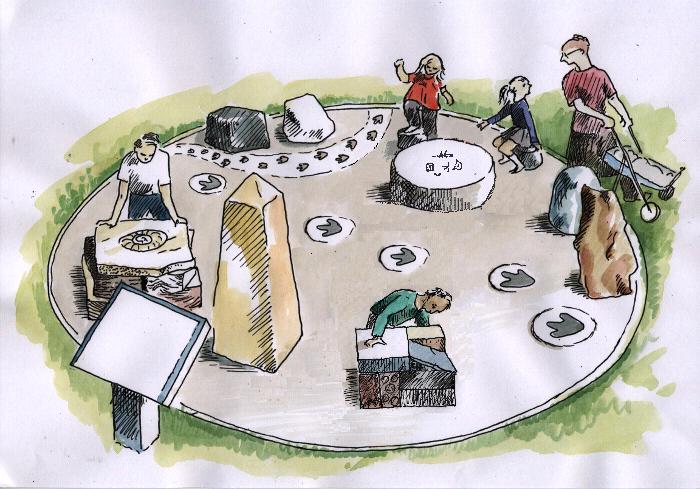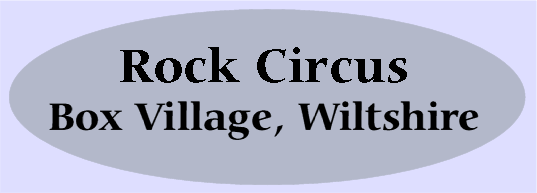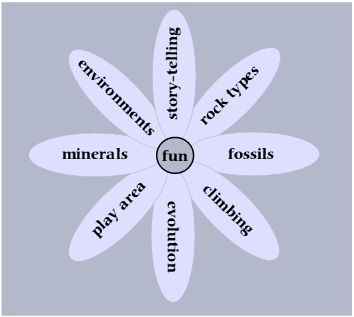1. Dynamic nature of the Earth.
Because rocks seem such permanent features in our landscapes, it is often not realised that they are constantly being weathered and eroded and worn down to sediment. These sediments are made of grains of various sizes which become compressed and compacted together to form sedimentary rocks. Constant plate movement slowly causes rocks to suffer tremendous heat and/or pressure; they re-crystallise to form metamorphic rocks. Eventually rocks melt and this magma cools and crystallises to form igneous rocks. Eventually, following plate movements, the rocks are brought back to the surface and the cycle starts again.
The Earth science requirements at KS2 and 3 of the Science and Geography curricula can be taught using the Rock Circus.
2. Rocky stories
What was it like to be there when these rocks formed? - in a tropical sea or on the slopes of a violent volcano?
3. Rocky uses
Rocks have many uses:- building stone, decorative stone, waterproof roofs, statues, gravestones, field boundaries, roads, bridges, storing water and oil, clues to prehistoric life, stone circles and other religious monuments, rock climbing - - . What could the rocks in Box Rock Circus be used for?
4. The adventures of Box over time
All the large blocks of rock are from the south-west of England but careful examination of them shows that they were formed in different climatic conditions and in different conditions from now. Although there have been times on Earth with no ice at the poles, it has always been hotter at the equator than at the poles. The only explanation for the different climates shown by local rocks is that the plates have moved. The blocks demonstrate:-
• a volcano in the Mendip Hills
• tropical marine conditions
• hot desert
• conditions similar to those off the Bahamas today.
5. Life on Earth
The red dot timeline helps to explain the great length of geological time and shows that most evolution of life happened recently, (in geological time terms).
6. Stories told by dinosaur footprints
The dinosaur footprints can be used in a number of ways:-
• Was the big dinosaur a carnivore and the little one a herbivore or was it the other way round or were they both the same species?
• Did they leave their footprints at the same time?
• Were they walking or running?
• What was their weight? (figures for the depths of the footprints will be provided)
7. Fossil stories
The examples in the rock circus will lead to discussions about what is a fossil and how does an animal become fossilised. What are the chances of you being fossilised?
8. Mineral stories
Rocks are made of minerals. Discussions around the minerals shown will include 'What is a mineral?' 'How does it differ from a rock?' 'What is a crystal?'
9. Stone working in Box
We have been very fortunate to have built the Rock Circus when the world-famous Box Ground Bath Stone is available for the first time in 60 years. As the most durable and widely used of Bath Stones, the Box Ground stone is now commercially available from the new Hanson Bath and Portland quarrying development in Wiltshire. The new quarry is recognised as the single source of Box Ground stone in the UK. Box Ground has been used for over 1000 years as a building stone.
10. Working stone
Long ago, we could only cut out stone blocks with chisels; now we can use explosives and rock saws. What clues can you find to show how these blocks were cut out?
11. Access for the disabled
The circle will be accessible for wheelchairs across the grass from the car park. The rocks with their interesting shapes and textures will be tactile for the visually impaired and will stimulate interest for everyone.
12. Theatrical productions
The central part of the Circus can be used as a stage for productions of all kinds. Prose, poetry and art, especially that inspired by rocks and landscapes could be encouraged.
13. Circle time
Primary school children are used to ‘circle time’, sitting in a circle to tell a story. The Box Rock Circus provides an opportunity for ‘Circle time with a difference’
14. Another Wiltshire Circle
There are other circles of stone in Wiltshire, notably Stonehenge and Avebury; these could be discussed when visiting Box Rock Circus!





